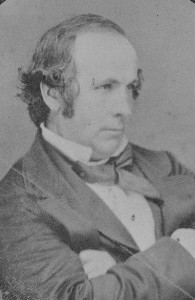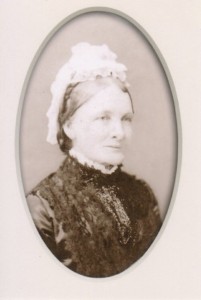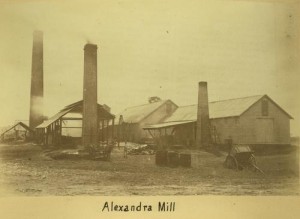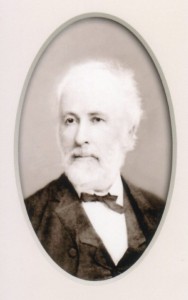Thomas Henry Fitzgerald
Sugar Planter
Submitted by: Pauline Hendry; Karen McCafferty
Read the full story of Thomas Henry Fitzgerald in the MFHS publication Early Settlers of Mackay 1860-1885.
Thomas Henry FITZGERALD was born on 1 December 1824 at Carrickmacross, Co Monaghan, Ireland, the son of Patrick Henry FitzGerald and Anne Dunoyer. He qualified at the age of 18 as a civil engineer entitled to practise as a builder of bridges, and as an architect and surveyor.
Arriving in New Zealand in 1842, he engaged in the surveying and supervising of various construction works in Wellington. On 2 July 1851 he married Jessie WILSON in Wellington. Jessie was born on 12 November 1832 at Kilmarnock, Ayrshire, Scotland, the daughter of James George Wilson and Ann Love. Jessie had arrived in New Zealand with her parents in 1839 on board the Bengal Merchant.
Thomas and Jessie had 11 children – Mary (born 14 April 1853), Joseph Bernard (Joe) (born 1855), James Francis (Jim) (born 1857), John Patrick (born 27 December 1859), Thomas Henry Jr (Tom) (born 3 January 1861), Annie (born 12 December 1863), Charles Borromeo (born 28 June 1865), Agnes Helen (born 28 August 1867), Henry (born 14 December 1869), Vincent Patrick (Vin) (born 25 April 1872) and Bernard Peter Joseph (born 3 March 1876).
In 1853, Thomas was appointed to survey some of the newly acquired land in the Hawkes Bay area. He and Jessie bought many of the blocks of land newly opened up for sale and, it was around this time that Thomas turned to business interests. He acquired more land, erected buildings (including a steam flour mill), operated a store, was an agent for trade, as well as an insurance agent, and was involved in the shipping of wool.
By the 1860s, Thomas had become one of the best known public figures in Hawkes Bay and was also a local politician being a member of the Provincial Council and also the House of Representatives of New Zealand for the electorate of Hawkes Bay from April to November 1960.
Around early July 1862, Thomas left New Zealand for Australia, and Jessie, with four children (Joseph, James, John and Thomas Jr) followed on 25 July 1862. Their first child, Mary, and niece, Bessie Tyser, were left behind in New Zealand as boarders at the Wellington Convent, not rejoining the family until seven years later in Mackay.
In 1863 Thomas was employed as a surveyor by the Lands Department and as a consequence surveyed and laid out the street plan for the then Port of Mackay. During this process, he acquired his original block of land in Mackay – a two mile frontage stretching south to Nebo Road. He named this plot Alexandra. In time, Thomas secured more land including The Palms and Meadowlands (near the Lagoons), and also secured control of Te Kowai (named after his estate in New Zealand) and Peri (Selection No 15).
A partnership with John Ewan Davidson was established in 1867 and later that year the first mill, Alexandra Mill, was erected. Thomas served briefly in the third Queensland Parliament representing Rockhampton from 29 June to 11 June 1867. Towards the end of the same year, he was back in Parliament representing Kennedy, this being the fourth Queensland Parliament. He was a member of the Legislative Assembly from 5 September 1867 to 11 June 1869. Further political appointments saw him as Colonial Treasurer in the Lilley Ministry from November 1868 to January 1869.
In 1875, after torrential rain in April and May, rust again attacked most of the cane in the Mackay district, and Thomas was the outstanding casualty. The banks foreclosed on him in 1876, giving him no chance to regain financial stability, and Thomas with his family left Mackay in June 1876.
This time, Thomas brought his family to Brisbane where he established a home on Gregory Terrace. Over the next three years he was forced to fall back on his old profession of surveying. He ventured north to explore the North Queensland rivers. These initial surveys of the Johnstone River area formed the basis of the original selections taken out by Thomas in 1880. Clearing work for planting began on 15 June 1880.
Though the first crushing was not quite the success Thomas had hoped for, it did arouse great interest in the area, causing an influx of new settlers. The area was initially called Geraldton, but was changed around 1910 to Innisfail, the name of Thomas’ holdings in the area, and the romantic name for Ireland.
Thomas’ second crushing was unsuccessful and neither of the two following annual crushings that he was involved in were as successful as had been hoped. At the same time, bigger financial interests, especially the CSR, were becoming involved in the area, and Thomas’ grand dreams were destined to fade quietly away. His health had also begun to cause him some concern and so, on 30 June 1885, he severed his connection with Innisfail and retired to Brisbane.
He joined Jessie and the younger family members at Teneriffe where he lived quietly for the next three years. On 10 November 1888 he died and was buried in the Nudgee Cemetery. Jessie died on 27 June 1901 in Brisbane and was buried with her husband.
Three of their children committed themselves to a lifetime of ministry within the Catholic Church – Mary, Mother Mary Audeon RSM; Agnes Helen, Sister Mary Agnes RSC and Henry, Monsignor Henry FitzGerald.
- Joe FitzGerald married Mary Anne Hensley 5 January 1907
- Jim FitzGerald married Laura Catherine Martin 18 November 1886
- John FitzGerald did not marry
- Tom FitzGerald married Annie Maude O’Malley 8 February 1888
- Annie FitzGerald married John Devoy 27 October 1897
- Charles FitzGerald married Joan Mary Cahill 20 May 1895
- Vin FitzGerald did not marry
- Bernard FitzGerald married Gertrude Ann Spain 29 April 1914




